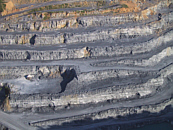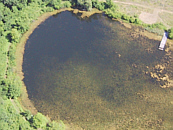 |
















 The storage area of a gravel The storage area of a gravel
pit. Acre upon acre of loose
piles
of dangerous footing
for ground searchers. Not a
problem for
ELLASS. The
extremely hazardous The
extremely hazardous
environment presented by
quarry walls would be
a
nightmare for people on
foot. ELLASS can cover
these areas quickly
and
safely. Finding a
person in a corn- Finding a
person in a corn-
field, on foot, is an exersize
in frustration. From the
air
the task is much easier. The bottom of ponds are The bottom of ponds are
clearly visible from the
air. |

What is
ELLASS?
ELLASS stands for Emergency
Low Level Aerial
Search and Surveillance. It's a service which
enhances the search and rescue capabilities of police, fire departments and
search & rescue teams.
How does ELLASS enhance their
capabilities?
A person is missing; the clock is ticking... Time is
of the essence. The police and fire departments are contacted, search &
rescue teams are organized, grids plotted, and the search personel set
out.
These are the tried and true methods used to locate missing
persons. Now search & rescue teams have another resource they can use:
ELLASS. When ELLASS is called in, a low level aerial search team can cover the
grids much more efficiently from the air, in coordination with the ground
teams, allowing the manpower on the ground to be utilized much more
efficiently.
What advantages are offered by
ELLASS?
Currently the choices for low level aerial search are either
light planes or helicopters. While both have advantages, they also have
drawbacks when searching for signs of missing people:
- Light airplanes, even at only 50 or 60 miles per hour, fly too fast
to allow thorough low level ground surveillance. Also, airplanes aren't
designed for the people inside to look straight down. Therefore the planes must
fly in a "banked" manner, a very inefficient way to fly, or search while flying
in circles.
- Helicopters are much better for locating missing persons, as they can
fly slowly, hover, and offer excellent fields of view. The major drawback to
helicopters is their operational and maintenance expenses, ranging from $150 to
$300 an hour.
By using two seat
powerchute craft, a thorough aerial surveillance may be performed while
simultaneously training students to fly. These are a few of the advantages of
using powerchutes:
- One person (from
ELLASS) is the pilot, and acts as a second set of eyes, while the second
occupant, a student pilot, and preferably someone from the local area who has a
thorough knowledge of the area to be searched, is both learning to fly as well
as searching for the missing person. Both persons have a virtually unobstructed
view.
- The craft moves at
only 30 miles per hour, 1/3 to 1/2 the speed of an airplane, allowing a
thorough search.
- In addition to its
slow speed, the craft is capable of flying very low if necessary, to be certain
nothing is missed. Trying to search the ground from higher than a few hundred
feet is almost useless. An airplane only a few hundred feet off the ground is
moving too fast.
- Support for the craft
is minimal, and it can take off and land in almost any open space a few hundred
feet long. No airports, long landing strips, or high maintenance as with
helicopters.
How does ELLASS
fit into an existing infrastructure?
ELLASS can work in a coordinated effort with the ground search teams,
flying a crisscross grid search pattern guided by GPS which assures that the
area searched is covered methodically and thoroughly. The man-hours efficiency
of the ELLASS search is clearly demonstrated in this example:
- Area to be searched: 5
square miles.
- Time to search it by
ELLASS in a crisscross grid with double coverage in 500 foot wide sweeps: 8
hours. Man hours: 16 (2 men used.) If 2 powerchutes are flown simultaneously,
then 4 men are used and the search time drops to 4 hours, and the man hours
remains the same.
- Time to search the
same area by foot, double sweep, using men spaced at 100 foot intervals: 4
hours. Man hours: 212 (53 men used).
Clearly the extra man
hours could be put to better use searching in places that aerial surveillance
cannot reach, such as inside homes, caves, culverts, sewers, dumpsters,
shopping centers and malls, etc...
The previous example also assumes a "best case" scenario, where the
terrain is fairly open and easy to traverse. The photos to the left show
terrain which would be very time consuming, as well as very dangerous to search
by foot. Yet ELLASS would be able to search these areas quickly and
safely.
What equipment is
used?
ELLASS craft are outfitted
with:
- Complete
communications gear, allowing contact with ground search teams, as well as
other aircraft and airport control towers.
- GPS, allowing the
ELLASS craft to search in grids, as well as provide the means for reporting
exact positions on the ground if potential evidence, or the object of the
search is located.
- High-powered
binoculars, allowing the ELLASS crew to "zoom in" on the
terrain.
Once additional
funding is available, the ELLASS craft may also be outfitted with:
- Frame-mounted video
cameras, recording a 360o view of the area searched. The tapes may
then be viewed by ground personnel for anything missed in the initial
search.
- Transmitting
capability for the video cameras, allowing ground personnel to view on
monitors, in real-time, the area searched by ELLASS. This means that ELLASS
will be providing a platform for additional sets of eyes to thoroughly comb the
search area, assuring nothing is overlooked.
- Infrared and thermal
detection equipment, providing a means for ELLASS to locate missing persons who
are hidden under brush, in tall vegetation, or even in shallow
holes.
Are there weather
limitations?
Yes. Wind is the
main "limiting" factor. Winds of over 15 miles per hour make flying conditions
hazardous, and the decision of whether or not to lift off is made by the
pilot(s) on the scene.
Other conditions which keep powerchutes on the
ground are rain, snow and fog. Powerchutes and inclement weather don't
mix.
Powerchutes are not allowed to fly at night. If outfitted with an
aerial strobe, it is permissable to lift off 30 minutes before sunrise, and
land up to 30 minutes after sunset.
Lastly, powerchutes are not allowed
to fly over "congested" areas of towns or cities.
Where is ELLASS available?
The goal is to eventually
have ELLASS chapters in every state. To achieve that, we are
developing procedures and protocols by working with police,
fire departments and search & rescue teams. However,
if you are in need of the services provided by ELLASS, no
matter where you are located, contact us immediately
and we'll do our best to arrive on scene as quickly as possible.
More about ELLASS
ELLASS, a project of the PowerChute Education Foundation, Inc. (an
IRS approved 501(c)(3) publicly supported tax exempt non-profit organization),
exists to provide emergency low level aerial search and surveillance services
in support of ground search and rescue teams looking for missing persons. (Or
anything that's missing, for that matter....)
|
 |
